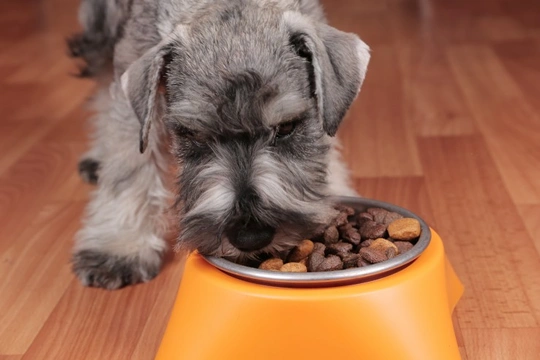
What does it mean if your dog moves their food away from their bowl?
Most dogs have an almost prescient knowledge of when they’re about to be fed, even before you get up and start rattling the bowls, and when that food does get put down for your dog, most pooches will dive straight in and wolf it all down as fast as possible.
Convincing dogs to eat is rarely a problem, and stopping them from eating things they shouldn’t eat is usually more of an issue for owners, but some dogs display some fairly unusual behaviours around food, or have their own little rituals in place surrounding meal times and eating, and they may even refuse to eat until they have carried them out!
One such behaviour that can be confusing for dog owners is if your dog doesn’t jump straight in with chowing down, but instead moves their food elsewhere first – either taking mouthfuls from the bowl and eating them on the floor, moving the whole bowl complete with food elsewhere, or taking individual bites of food to another location before eating them.
All of this tells you that something about where or how you’re feeding your dog, or the bowl that you place their food in, isn’t suiting your dog’s preferences – but why?
In this article, we will look at why your dog might move their food before they actually eat it, which can help you work out what’s going on in your dog’s mind and adjust their feeding routine accordingly. Read on to learn more.
Competition for food
One of the most common reasons for a dog moving their food to another location is feeding two or more dogs in close quarters – either side by side, or simply in the same room.
If another dog eats the first dog’s food, particularly if they push them away or take it, the other dog won’t relax to eat, and may become snappy or defensive about it – or if they are submissive to the other dog, they will probably just surrender their meal. However, over time your dog will look for ways to safeguard their food, which may mean moving it away.
Even if the other dog doesn’t take the first dog’s food or if you supervise the dogs to ensure this doesn’t happen, simply being too close to other dogs when eating is uncomfortable for some, and mat result in behaviours like moving the food.
Dogs need to feel safe to eat
Dogs concentrate on their food when they’re eating, and they won’t do this if they don’t feel safe or a lot is going on around them. If you feed your dog somewhere noisy, busy or with lots going on (like the kitchen when other pets and people are around or walking in and out) and this disturbs your dog, they may eat faster, not eat at all, or take their food off somewhere quieter.
Ensure that your dog has peace and quiet when they’re eating, and that they won’t be disturbed.
Hoarding resources
As mentioned, dogs tend to eat whatever they can whenever they can, but some dogs will try to hoard or save resources too. If your dog has eaten enough, they may move the rest of their food to bury or hide for later, as wild dogs sometimes do when food is plentiful.
If this is the case, your dog may display similar behaviours with food, toys and treats, and you may find that you have to check your dog’s hiding places regularly to remove anything that might be getting a bit manky!
The bowl itself
If your dog’s bowl is too small, high, low, or otherwise not well set up to be comfortable for your dog to eat from, they might be moving food because they dislike the bowl itself.
One of the most common causes for a dog disliking their food bowl is also one of the easiest to fix – if your dog’s ID tags clink or catch on the bowl when they’re eating, this might bother or disturb them and cause them to move food.
Choosing different collar tags that won’t clink together can help. Also, make sure that your dog’s food bowl is always clean before you add more food to it, and that it is made of a material that won’t taint the taste of the food over time, as some plastics can.
Learned behaviours
As is the case with a great many different unusual behaviours that dogs might display, behaviours may begin due to a specific pinpointed cause or trigger, but over time, those behaviours can become a pattern that the dog repeats even when the initial stimulus or trigger is no longer relevant.
If your dog has established a feeding ritual of moving their food for one of the reasons above, they may continue to do so when the reason in question is no longer valid – or your dog may have learned to eat in this way as a result of observing the same behaviour in another dog that they live with too.



